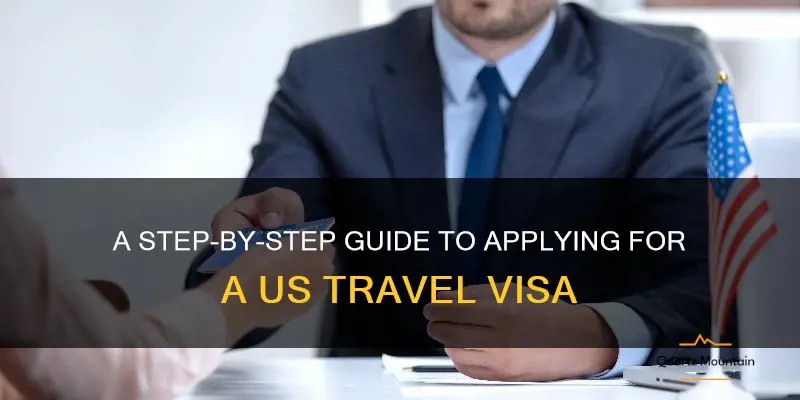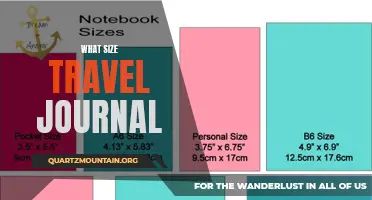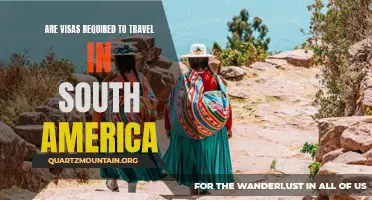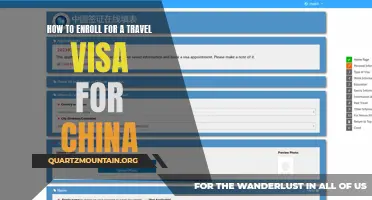
Planning to travel to the United States? Navigating the maze of visa applications can be overwhelming. But fear not! We have your back with this step-by-step guide on how to apply for a US travel visa. Whether you're a tourist, a student, or a business professional, our comprehensive guide will break down the visa application process into manageable steps, helping you understand the requirements and ensuring a smooth and hassle-free journey to the land of the free. So, grab your passports and let's dive into the world of US travel visas!
| Characteristics | Values |
|---|---|
| Visa Type | B1/B2 |
| Application Form | DS-160 |
| Passport | Must be valid for at least 6 months beyond the intended stay |
| Photo | Recent color photograph with specific size and background requirements |
| Payment | Visa application fee |
| Interview | Required for most applicants aged 14 to 79 |
| Supporting Documents | May include travel itinerary, proof of financial resources, and purpose of visit |
| Additional Information | Potential for fingerprinting and digital photograph at the embassy or consulate |
What You'll Learn

Types of US travel visas: Overview and requirements
If you’re planning a trip to the United States, you may need to apply for a travel visa. The US offers different types of visas depending on the purpose of your visit. It’s important to understand the requirements and process for each visa type to ensure a smooth application process. In this article, we’ll provide an overview of the different types of US travel visas and their requirements.
B-1/B-2 Visitor Visa:
The B-1/B-2 visa is a popular choice for tourists and business travelers. It allows you to visit the US for tourism, business meetings, conferences, and medical treatments. The requirements for a B-1/B-2 visa include a valid passport, a completed application form (DS-160), proof of financial stability, and evidence of your ties to your home country, such as property or employment. You may also need to provide a letter of invitation or a detailed itinerary.
F-1 Student Visa:
If you plan to study in the United States, you’ll need an F-1 visa. To qualify, you must have been accepted by a US educational institution and show proof of financial resources to cover your tuition and living expenses. You will also need to provide evidence of ties to your home country and proof of your intent to return after completing your studies.
J-1 Exchange Visitor Visa:
The J-1 visa is for individuals participating in approved exchange visitor programs, such as internships, work and travel programs, or research programs. The eligibility requirements for a J-1 visa vary depending on the specific program, but generally, you will need to be sponsored by an approved organization and demonstrate sufficient funds to support yourself during your stay. You may also need to provide evidence of health insurance coverage and proof of ties to your home country.
H-1B Work Visa:
The H-1B visa is for skilled workers who have been offered employment by a US company. To be eligible, you must have a job offer from a US employer, possess specialized knowledge, and have at least a bachelor’s degree or equivalent work experience in the field. Additionally, the US employer must file a petition on your behalf.
K-1 Fiancé(e) Visa:
If you’re engaged to a US citizen and plan to get married in the United States, you can apply for a K-1 fiancé(e) visa. To qualify, you must provide evidence of a genuine relationship, clear intention to marry, and meet certain financial requirements. Once married, you can apply for a change of status to become a permanent resident.
These are just a few examples of the types of US travel visas available. The specific requirements and application process can vary widely, so it’s essential to thoroughly research the visa you need and ensure you have all the necessary documentation. The US Department of State’s official website provides detailed information on each visa category, including application forms, fees, and processing times. It’s crucial to start your visa application well in advance of your planned travel dates to allow for any potential delays or additional requirements.
Traveling on a K3 Visa: Everything You Need to Know
You may want to see also

Step-by-step guide: The application process for a US travel visa
Traveling to the United States can be an exciting and memorable experience. To ensure a seamless journey, it is important to understand and complete the application process for a US travel visa. In this step-by-step guide, we will walk you through the entire process and provide helpful tips along the way.
Step 1: Determine the type of visa you need
Before starting the application process, it is crucial to identify the type of US travel visa you require. Common types of visas include the B-1 visa for business purposes, the B-2 visa for tourism and vacation, and the J-1 visa for exchange visitors. Visiting the official website of the US Department of State can provide extensive information on different visa categories and their specific requirements.
Step 2: Complete the DS-160 form
The DS-160 form is an online application that requires detailed information about your personal background, travel plans, and purpose of visiting the United States. Take your time to carefully fill out all portions of the form, ensuring accuracy and correctness. Once completed, submit the form electronically and keep the confirmation page for your records.
Step 3: Pay the visa application fee
After completing the DS-160 form, you will need to pay the visa application fee. The fee amount varies depending on the type of visa you are applying for, so make sure to check the current fee on the US Department of State website. Payment can be made online, and you will receive a receipt as proof of payment.
Step 4: Schedule an interview
Most US travel visa applicants are required to attend an interview at the US embassy or consulate in their home country. The interview is an opportunity for the consular officer to review your application and determine your eligibility for the visa. Visit the website of the US embassy or consulate in your country to schedule your interview appointment. It is recommended to schedule the appointment well in advance, as availability may vary.
Step 5: Gather supporting documents
Before attending your interview, gather all necessary supporting documents to prove your eligibility for the visa. Commonly required documents include a valid passport, the DS-160 confirmation page, the visa application fee receipt, and any additional documents specific to your visa category. It is advisable to organize and bring photocopies of all documents, as well as the originals.
Step 6: Attend the visa interview
On the day of your scheduled interview, arrive at the embassy or consulate early to allow for security checks and registration. Dress appropriately and prepare to answer questions related to your travel plans, financial resources, and ties to your home country. Be honest and confident in your responses. The consular officer will also collect your fingerprints as part of the interview process.
Step 7: Wait for visa processing
After the interview, the consular officer will inform you of the decision on your visa application. If approved, your visa will be affixed to your passport, and you will be provided with additional instructions on how to collect it. The processing time can vary, so be prepared for potential delays. In case your visa application is denied, the consular officer will explain the reasons for the refusal.
Step 8: Plan your trip
Once you receive your US travel visa, you can start planning your trip to the United States. Make sure to review the visa validity dates and any specific entry restrictions imposed. It is also recommended to purchase travel insurance and make necessary arrangements for accommodations and transportation.
By following this step-by-step guide, you can navigate the application process for a US travel visa with confidence. Remember to thoroughly review the application requirements, pay attention to details, and prepare for your interview to increase your chances of getting approved. Safe travels!
Exploring the Possibility of Traveling to Canada on a Student Visa
You may want to see also

Documents needed: A checklist for US travel visa applications
If you are planning to visit the United States, you will most likely need a travel visa. Applying for a US travel visa can be a complex process, as there are several documents and requirements that you need to fulfill. To help you navigate through this process, we have put together a checklist of the required documents for a US travel visa application:
- Valid passport: Your passport must be valid for at least six months beyond your intended stay in the United States.
- Nonimmigrant visa application form: You need to complete the online nonimmigrant visa application form DS-160. This form can be found on the official website of the US Department of State.
- Photo: You will need to provide a recent photograph taken within the last six months. The photograph must meet the specific requirements set by the US government, such as size, color, and background.
- Visa application fee: You will need to pay a nonrefundable visa application fee. The fee amount may vary depending on the type of visa you are applying for. You can find the fee schedule on the website of the US Department of State.
- Interview appointment: After completing the online application form and paying the visa fee, you will need to schedule an appointment for an interview at the nearest US embassy or consulate. The waiting time for an interview appointment can vary, so it is advised to schedule your appointment well in advance of your intended travel date.
- Supporting documents: You will need to provide various supporting documents to demonstrate the purpose of your trip and your ties to your home country. These documents may include, but are not limited to:
- Travel itinerary: This includes details of your flight bookings, hotel reservations, and any planned activities or tours during your stay in the United States.
- Letter of invitation: If you are visiting friends or family in the United States, you may need a letter of invitation from them, stating their relationship to you and the purpose of your visit.
- Proof of financial means: You will need to show that you have sufficient funds to cover your expenses during your stay in the United States. This can be demonstrated through bank statements, employment letters, or sponsorship letters.
- Employment or study documents: If you are employed or enrolled in a course of study, you may need to provide documents such as employment letters, pay slips, or enrollment certificates to show your ties to your home country and your intention to return after your trip.
- Proof of ties to your home country: It is important to demonstrate that you have strong ties to your home country and that you have no intention of overstaying your visa. This can be done by providing documents such as property ownership, family ties, or a letter from your employer stating your planned return to work.
Additional requirements: Depending on your individual circumstances, you may need to provide additional documents. For example, if you have previously been refused a US visa or if you have a criminal record, you should be prepared to provide additional documentation to address these issues.
It is important to note that this checklist is only a general guide, and the specific requirements for a US travel visa application may vary depending on your country of citizenship and the type of visa you are applying for. It is recommended to consult the website of the US embassy or consulate in your home country for detailed and up-to-date information on the application process and requirements.
Can Indians Travel to US on Tourist Visa?
You may want to see also

Helpful tips: Maximizing your chances of a successful US travel visa application
Planning a trip to the United States can be an exciting experience, but navigating the visa application process can sometimes be a daunting task. To increase your chances of a successful US travel visa application, it is essential to be well-prepared and aware of the steps involved. Here are some helpful tips to guide you through the process:
Determine the type of visa you need:
The US offers various types of nonimmigrant visas, such as tourist visas (B-2), business visas (B-1), student visas (F-1), and work visas (H-1B), among others. Get familiar with the different visa categories to determine the appropriate one for your purpose of travel.
Understand the application requirements:
Each visa category has specific requirements, including supporting documents, financial evidence, and proof of strong ties to your home country. Familiarize yourself with the exact requirements for your specific visa, as failure to submit the necessary documents can lead to rejection.
Complete the DS-160 form:
The DS-160 form is an online application that all nonimmigrant visa applicants must complete. Provide accurate information, as any inconsistencies or incorrect details can impact your application. Make sure to review and double-check your form before submitting it.
Pay the visa fee:
There is a non-refundable visa application fee that must be paid before your interview. Visit the official US embassy or consulate website for your country to find out the current fee and acceptable payment methods.
Schedule and attend your visa interview:
After completing the DS-160 form and paying the visa fee, you need to schedule an appointment for a visa interview at the US embassy or consulate in your country. The waiting time for an appointment can vary, so it's advisable to apply well in advance. Attend the interview on the scheduled date and time, dressed professionally and carrying all the required documents.
Be prepared for the interview:
The interview is a crucial step in the visa application process, where a consular officer determines your eligibility for a US travel visa. Practice answering potential questions about your travel plans, intent to return, financial stability, and ties to your home country. Bring all supporting documents to strengthen your case.
Show strong ties to your home country:
One of the critical factors in obtaining a US travel visa is demonstrating strong ties to your home country. This can include family, employment, property, or ongoing educational commitments. Providing evidence of these ties can help convince the consular officer that you intend to return after your visit.
Be honest and confident:
During the interview, it is essential to remain honest and confident in your responses. Avoid providing false information or withholding relevant details, as it can result in visa denial or future travel restrictions.
Follow up if necessary:
In case your visa application is put on hold or additional documents are requested, promptly fulfill the requirements. Following up on the status of your application displays your commitment and can help speed up the process.
Remember that each visa application is unique, and there are no guarantees of approval. By being well-prepared, understanding the requirements, and presenting a strong case during your visa interview, you can maximize your chances of obtaining a US travel visa. Start your application early, gather all the necessary documents, and approach the process with confidence. Good luck with your visa application and enjoy your trip to the United States!
Navigating International Travel After Applying for a Fiancé Visa
You may want to see also
Frequently asked questions
To apply for a US travel visa, you will need a valid passport, a completed visa application form, a passport-sized photo, proof of travel arrangements and accommodation, evidence of sufficient funds to cover your expenses, and any supporting documents that may be required based on the specific type of visa you are applying for.
The processing time for a US travel visa can vary depending on various factors, including the type of visa you are applying for and the current workload of the US embassy or consulate. Typically, it can take anywhere from a few days to a few weeks or even longer to receive a decision on your visa application. It is recommended to apply well in advance of your proposed travel dates to allow for sufficient processing time.
Yes, you can start the application process for a US travel visa online. However, the actual visa application will generally need to be submitted in person at a US embassy or consulate. Online applications can help streamline the process by allowing you to complete certain forms and pay the necessary fees online before scheduling an appointment for an in-person interview at the embassy or consulate.







